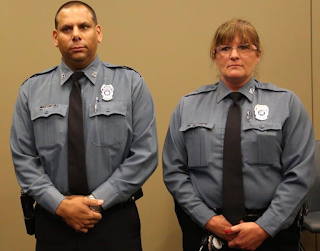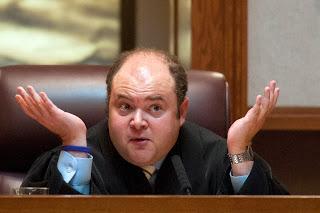
Ryan Stokes and his daughter
As yesterday's presidential election wound down, it was unclear if Americans were finished -- let us pray -- with Donald Trump's nightmarish "Reign of Error." But this is clear: We will be living with his wretched appointees to the federal bench for decades to come.
Take a fellow named David Stras -- please! Stras appears to be loyal to the far-right Federalist Society, of which he has been a member since 2003. But a case that originated in Missouri suggests his loyalty to he rule of law is not so clear.
Stras, a Donald Trump-appointed federal judge, has written an opinion that essentially forced a lower court to reverse its earlier ruling and find that a Kansas City, MO, police officer enjoyed immunity for fatally shooting an unarmed black man in the back.
Stras, appointed by Trump to the Eighth Circuit Court of Appeals in 2017, wrote the opinion for a three-judge panel, and it appears to conflict with established law for making determinations about immunity at the summary-judgment phase of a federal lawsuit. To make an ugly case even uglier, published reports indicate police officials lied about central elements of the case -- and even granted two officers (William Thompson and partner Tamara Jones) awards for their actions before later rescinding them.
The court case -- N.S., et al v. Kansas City Board of Police Commissioners, et al (8th Cir., 2019) -- grew from officer Thompson's fatal shooting of Ryan Stokes on July 28, 2013, in the Kansas City Power and Light District. N.S. is the only child of the decedent, and co-plaintiff Narene James is his mother. Here is how flatlandkc.org, in a 2015 article, describes events of that evening:
After midnight on July 28th, 2013, Ryan Stokes and Ollie Outley drove in Outley’s red Monte Carlo to the Power and Light District. They parked off of McGee St., which runs north and south between 12th and 13th streets.
Outley drove.
There they met up with friends and spent the next two hours walking the perimeter of Power and Light, hanging out, and talking with acquaintances. Friends describe the group as being in good spirits, having a good time.
At 2:30 a.m. when the bars closed, patrons poured out onto the sidewalks. Stokes stood with Outley and others, all of whom are African-American, at the corner of 13th Street and Grand Blvd.
A group of five white males, including Jordan Miller, 21, emerged from a nearby bar at Power and Light.
Miller would later tell police he and his friends were extremely intoxicated.“Hammered,” a friend told police.
They looked for a taxi cab big enough for all five, when Miller realized he had lost his cell phone. He accused Outley of taking it.
While Miller acknowledged later that he thought he must have dropped the phone on the sidewalk– and that he had never physically seen Outley holding his phone–he accused Outley at the time of taking it.
Miller yelled at Outley to give him his phone back. Outley denied having it. A shouting match ensued.
As the altercation escalated, surveillance video shows Stokes stepping in to act as peacemaker. No punches are thrown, but the yelling and shoving attracts the attention of Police Officer Albert Villafain.
Villafain, who was working Bike Patrol that evening, called for order. When the fight continued, he pepper sprayed the crowd, and people took off in all directions.
According to Outley and other witnesses, pepper spray got into Outley’s eyes. He gave the keys to his Monte Carlo to Stokes and told him to go get the car.
Video surveillance shows Stokes and his friend, Kenneth Cann, jogging east up 13th St. towards McGee St. and the parking lot.
The video shows both of Ryan Stokes’ hands, and they appear to be empty.According to police reports and surveillance video, Jordan Miller starts following Stokes. He then tells Villafain that Stokes or someone with him took his cell phone.
Villafain asked Miller if he could make a positive identification of the thief. Miller said he could. Villafain signaled another Police Officer, Daniel Straub, to assist in the pursuit of the two suspected phone thieves.
All three took off after Stokes.
The pursuit ended when Stokes reached a parking lot, encountered officer William Thompson, and opened the door to his friend's Monte Carlo. Thompson fired three shots, hitting Stokes twice in the back. The Stokes family, represented by Kansas City attorney Cynthia L. Short, sued for excessive force under federal civil-rights law and wrongful death under Missouri state law.

Officer William Thompson and his partner, Tamara Jones
At the trial-court level, Judge Brian Wimes (Western District of Missouri) denied immunity for Thompson and his police co-defendants. They sought review at the Eighth Circuit, where immunity issues properly can be considered on interlocutory appeal. They found a welcoming set of ears from the Stras panel, which overturned Wimes' ruling and remanded the case to the Western District, where Wimes had little choice but to write a second opinion, this time granting immunity to the cops.By all accounts we've found, it was a chaotic scene on the night of Ryan Stokes' death. Here are the uncontroverted material facts, as stated by both the trial and appellate courts:
Officer Thompson is a KCPD police officer, employed by the Board, who has been a KCPD officer for more than 20 years. In the early morning hours of July 28, 2013, Officer Thompson and his partner Officer Tamara Jones were on foot patrol in the parking lot located at McGee and 12th Streets in Kansas City, Missouri. Officers Thompson and Jones were assigned to clear the lower parking lot along the west side of Grand Boulevard between 12th and 13th Streets. Eventually, Officers Thompson and Jones moved to the upper level of the parking lot where the shooting at issue occurred.
Over dispatch radio, Officer Thompson heard from Officer Albert Villafain that a foot chase was headed in his direction. Officer Thompson heard the description of two suspects (black males wearing white T-shirts and shorts), the direction of the two suspects' travel, and the crime that had allegedly been committed, which was stealing. Seconds after Officer Thompson heard this information over the radio, he saw a black male, wearing a white T-shirt, come running around the corner of a building in the parking lot. This individual was Ryan Stokes.At the time of the incident, Stokes held his right hand closed, in front of himself, at waist level. Stokes jogged in Officer Thompson's direction, toward a red Monte Carlo that was parked just past the corner of the building in the parking lot. Stokes held his hands and arms close to his body as he ran, with his elbows bent, stationary, and close to his body.
Officer Thompson testified he saw a gun in Stokes' right hand, and Stokes looked at Officer Thompson and knew of his presence. Officer Jones testified she did not see Stokes with a gun, but she did not see Stokes' hands. Liberty, Missouri Police Officer Greg Powell testified he did not see a gun in Stokes' hand, but it was dark, and he could not see Stokes' hands. KCPD Officer Gregory Williams testified he did not see Stokes with a gun or anything that would have appeared as a gun. KCPD Officer Straub testified he did not see Stokes with a gun, but he also did not see Stokes' hands. Other witnesses testified Stokes was holding up his pants. Other witnesses testified they did not see Stokes with a gun at any point earlier that evening, including immediately before Officer Thompson saw Stokes.
Officer Thompson pointed a gun at Stokes as Stokes ran to the driver's side door of the Monte Carlo. Stokes' back was to Officer Thompson, at which point Officer Thompson could not see Stokes' hands. Stokes stepped away from the door of the vehicle. In his peripheral vision, Officer Thompson saw another police officer running around the same corner of the building around which Stokes had run. Stokes ran in the direction of the approaching officer, Officer Straub. Officer Straub saw Stokes stepping away from the Monte Carlo, and believed Stokes was obeying Officer Straub's commands to stop running and show Officer Straub his hands.
As Stokes moved away from the Monte Carlo, his back was to Officer Thompson, who could not see Stokes' right hand. However, Officer Thompson believed Stokes was armed and intended to ambush and shoot Officer Straub.
Officer Thompson shot Stokes from behind, and saw Stokes fall to the ground. Officer Thompson stopped shooting once he saw Stokes falling. About seven to ten seconds elapsed between when Officer Thompson saw Stokes and when Officer Thompson shot Stokes. Stokes was unarmed at the time of the shooting.
Thereafter, a gun was discovered on the driver's seat of the Monte Carlo. The gun belonged to Stokes' friend and owner of the Monte Carlo, Ollie Outley.
How do we know the Eighth Circuit panel got it wrong on the immunity issue, that the case should have moved past summary judgment to settlement or trial? The words of Stras, the Trump appointee, tell us so. From our post of 9/16/20:
How gross was the Stras panel's butchery of the N.S. case? To arrive at an answer to that question, we first need to consider the proper steps for considering summary judgment, as spelled out in case law and Rule 56 of the Federal Rules of Civil Procedure (FRCP). Here are three key elements:
(1) The evidence of the nonmovant (the Stokes family, in this case) is to be believed, and all justifiable inferences are to be drawn in his favor. Anderson v. Liberty Lobby Inc., 477 U.S. 242 (1986).
(2) Summary judgment is appropriate where there is no genuine issue of material fact, and “the moving party is entitled to a judgment as a matter of law.” Celotex Corp v. Catrett, 477 U.S. 317 (1986).
(3) In passing upon a motion for summary judgment, the court is required to view the facts in the light most favorable to the party opposing the motion and to give to that party the benefit of reasonable inferences to be drawn from underlying facts. Robert Johnson Grain Co. v. Chem. Interchange Co., 541 F. 2d 207 - Court of Appeals (8th Circuit, 1976). Adickes v. SH Kress and Co., 398 US 144
(Supreme Court 1970).
Did the Stras panel follow these straightforward provisions of summary-judgment law? Not even close. Let's consider Stras' own words from the N.S. opinion:Some evidence supports Thompson's account. The police discovered a handgun on the driver's seat of the car, which could mean that Stokes was armed when he entered the parking lot but then tossed the gun into the car. And witnesses who saw Stokes running said that he appeared to be "holding up his pants as he ran," which is arguably consistent with Thompson's perception that Stokes was holding a gun. Finally, Thompson's partner claims to have heard Thompson order Stokes to "get on the ground."
Other evidence supports the family's account. No one besides Thompson observed Stokes with a gun, nor was any gun found on or near his body. The car's owner, who was Stokes's friend, claimed that the gun recovered from the car belonged to him and that it had been there all night. Moreover, some officers did not recall hearing Thompson shout anything during the encounter, and at least one officer thought Stokes was trying to surrender when Thompson shot him.
Stras admits right up front that the evidence is mixed, with some of it favoring Officer Thompson's account, and some favoring the Stokes family's account. As the non-moving party, the Stokes family was entitled to have their factual allegations believed and "all justifiable inferences drawn in their favor." So, how could the Stras panel essentially force the trial court to grant summary judgment against them?
In Stras' own words, there were "multiple genuine issues of material fact," so summary judgment could not lawfully be granted. Why did the panel force summary judgment anyway? Is David Stras a rubber stamp for law enforcement? That's how it looks from here.

David Stras
